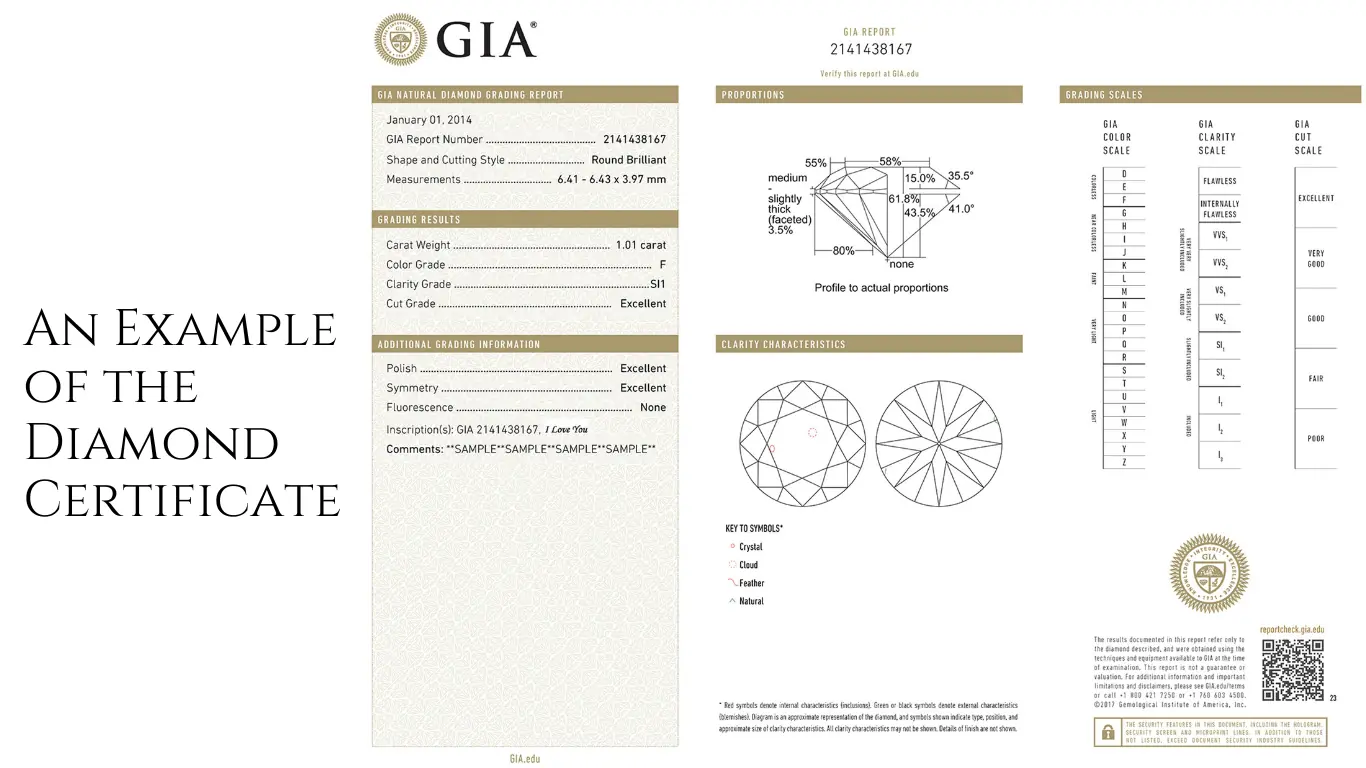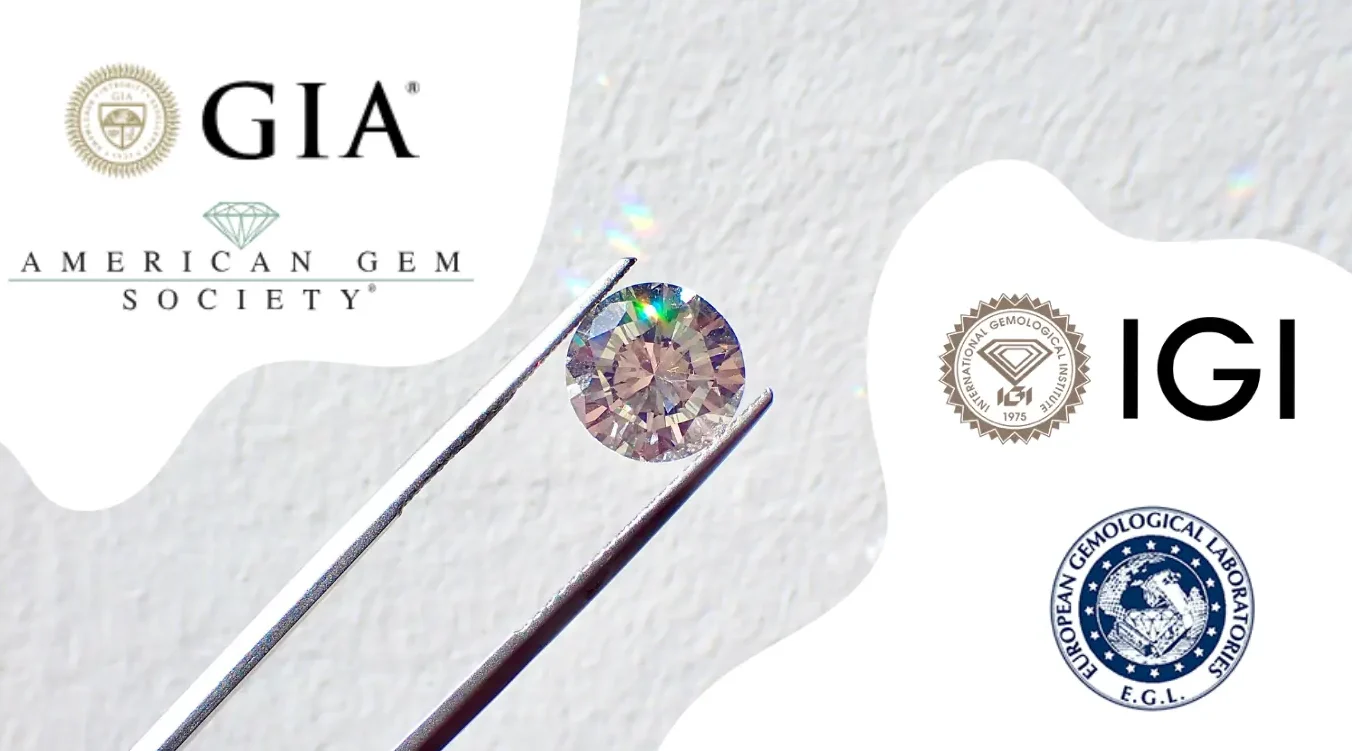A diamond certificate (grading report) is an overall rating aimed by an independent laboratory detailing the characteristics and quality of a diamond. This document is essential as it delivers a precise and impartial assessment of a diamond’s attributes, which are the four most critical elements of a diamond – clarity, color, cut, and carat weight, also known as the 4Cs.
Why you shouldn’t buy diamonds without a grading report
The answer lies in the assurance and transparency that the seller provides. Purchasing a certified diamond means you’re not merely relying on the seller’s word. The report tells you exactly what you’re getting – its size, how clear it is, the color, and how well it’s been cut. These aren’t just fancy terms, they decide how good the diamond looks and, importantly, how much it’s worth.
That report ensures you’re not overpaying for something that looks nice but doesn’t cut it in quality. Someday you might want to trade up or sell that diamond. Without a grading report, proving your diamond’s worth to someone else will be tough.
Main Elements of a Diamond Certificate
A diamond certification offers a wealth of information. But, there are 4 key areas to focus on:
- Carat Weight: This measures the diamond’s weight, not its size. One carat is equivalent to 0.2 grams. The more carats – the higher is price.
- Cut Quality: The diamond’s symmetry, brilliance, and overall look depend on how well it was cut. A high-quality cut increases the diamond’s fire (the dispersion of light into colors), and sparkles. The cut grade is probably the most crucial aspect affecting a diamond’s aesthetic appeal.
- Color Grade: The purity of the color in a diamond, with grades ranging from D (colorless) to Z (light). The closer a diamond is to colorlessness, the higher its value, which adds brilliance to the gem.
- Clarity Grade: The presence of inclusions or blemishes, with grades from Flawless (FL) to Included (I).

Which Diamond Certificate is the Best?
Each lab has its own set of grading standards and practices, making some more stringent than others. Here’s an overview of the most popular labs and insights into their differences to help you understand which might be “better” depending on your needs.
Here are 4 most popular diamond grading labs:
- Gemological Institute of America (GIA)
- American Gem Society (AGS)
- International Gemological Institute (IGI)
- European Gemological Laboratory (EGL)
Gemological Institute of America (GIA)
The GIA is widely regarded as the most reliable and authoritative diamond grading entity in the world. Founded in 1931, the institute is credited with developing the International Diamond Grading System and the 4Cs (Cut, Color, Clarity, and Carat Weight) used globally today. GIA certifications are highly valued for their strict grading standards and consistency.
GIA’s mission is to ensure the public trust in gems and jewelry by upholding the highest standards of integrity, academics, science, and professionalism through education, research, laboratory services, and instrument development.
If you’re looking for the highest level of assurance in a diamond’s qualities, a GIA certification is the gold standard. The biggest advantage of the GIA is that they don’t have any financial interest in the sale of gemstones, which makes it more independent in their work.
American Gem Society (AGS)
The AGS is known for its scientific approach to the cut quality of diamonds. Established in 1934, this lab introduced the first scientifically reviewed, objective, and repeatable cut-grade method. AGS is particularly respected for its rigorous evaluation of diamond cuts, using a 0 to 10 grading scale, where 0 represents the highest grade. Buyers prioritizing the brilliance and quality of a diamond’s cut might find AGS-certified diamonds particularly appealing.
Sometimes, if a diamond’s color or clarity is on the borderline between two grades, the seller might send the diamond to several labs hoping for a higher grade. For instance, if a diamond gets a J color rating from GIA but is close to an I color, the seller might try their luck with AGS to get that I rating, which could let them sell the diamond for more. While it’s more common for different labs to give the same grade, there’s still a chance for an “upgrade” that justifies the cost of getting another certification. Earlier, we compared H color diamonds with higher colors, where you can see a very subtle difference between them.
If you’re looking for help picking out diamond jewelry or just diamonds certified by the GIA or AGS, we provide a list of reliable jewelry stores with honest reviews and ratings.
International Gemological Institute (IGI)
IGI, established in 1975, is one of the largest diamond certification organizations globally, offering a wide range of services including grading for diamonds, colored stones, and jewelry. IGI is considered to have a more lenient grading system compared to GIA, but it is particularly popular for certifying lab-grown diamonds and is well-regarded in that segment of the market.

European Gemological Laboratory (EGL)
EGL is known for introducing diamond grading to broader markets and is often credited with creating a market for diamonds that don’t fit into the traditional categories preferred by other labs. While EGL certifications can offer more affordable options for consumers, it’s important to note that their grading standards are often considered less stringent than those of GIA or AGS. This can result in higher grade assignments for color and clarity compared to the GIA/AGS, potentially making diamonds appear of higher quality on paper than they might be considered by the stricter standards of GIA or AGS. One reason these labs might differ from the GIA is that they operate as for-profit businesses. This means they have a financial incentive to give clients the positive quality grades they want to see. So, we don’t recommend choosing diamonds with the European Gemological Laboratory certificates.
The “better” certification depends on what you value most in a diamond purchase. For those prioritizing the utmost accuracy and reliability, GIA is often considered the best choice. If the quality of the cut is your primary concern, AGS may be the preferable lab due to its detailed analysis of this aspect. For those looking into more budget-friendly options or lab-grown diamonds, EGL and IGI might provide suitable alternatives, offering detailed reports with a slightly more lenient grading scale. If you think, what’s better IGI vs GIA, we highly recommend choosing diamonds with GIA or AGS certificates.

